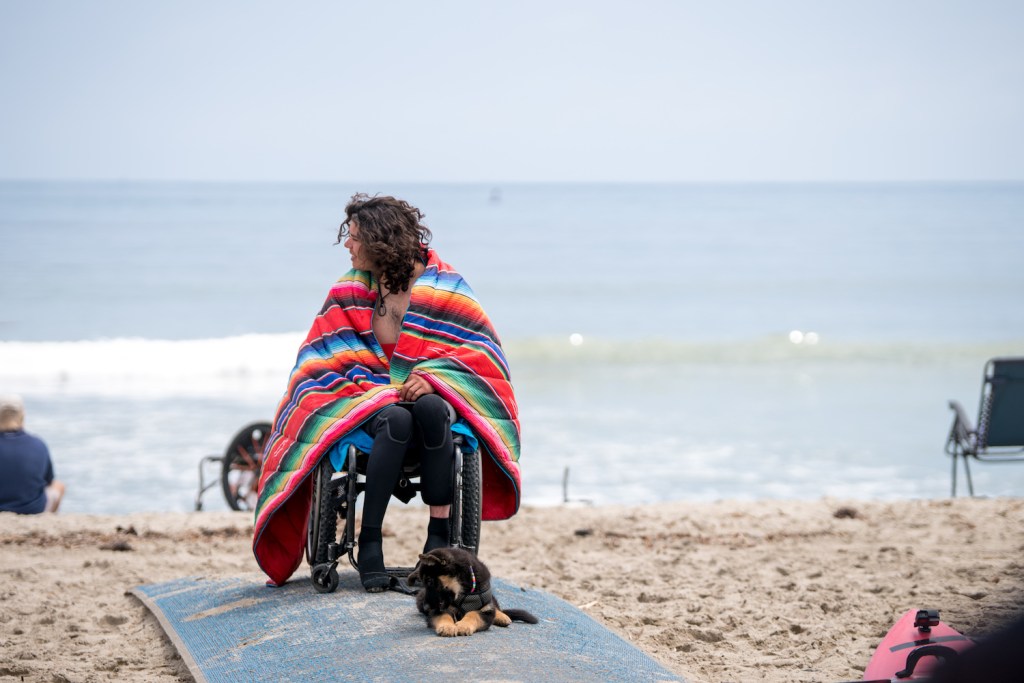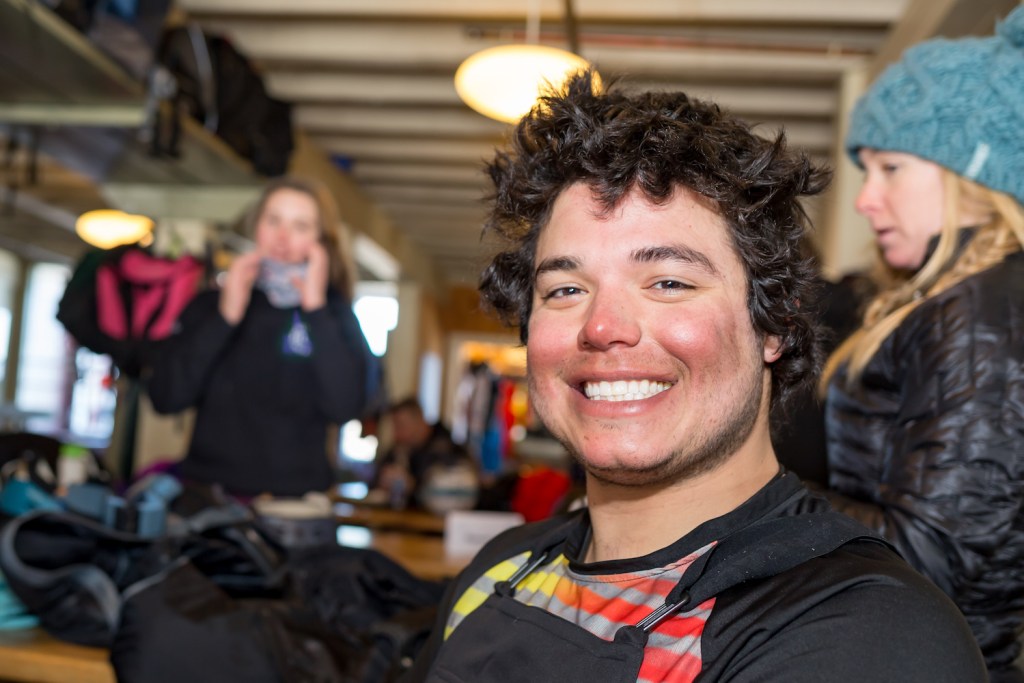Trevor Kennison imagined skiing Corbet’s Couloir—Jackson Hole, Wyoming’s iconic and nearly vertical chute with a dicey, dramatic entrance—six times in his head while waiting at the top. He closed his eyes, took three fast breaths, then visualized it: Ride the ramp at just the right speed, hit the takeoff, hug the rocks on skier’s left, then stick the landing into the chute. If he could picture it going perfectly in his head, he knew he could pull it off.
He’d wanted to ski this line for years and finally, the day had come. Kennison, who’s paralyzed from the waist down, says he wasn’t scared. “I knew what I had to do. I was ready,” Kennison, 26, said. “Everything I do is calculated risk. I think, where is it going to go wrong? I learn so much from the people around me.”
It was mid-February at the Kings and Queens of Corbet’s, a unique big-mountain competition where skiers and riders are judged by their fellow athletes on their line, style and fluidity down Corbet’s Couloir. The event, which began in 2018, is the brainchild of former pro skier Jess McMillan, who competed on the Freeride World Tour for 10 years and now works as Jackson Hole Mountain Resort’s events manager. “I wanted Kings and Queens to be more about the athletes and being in the mountains, less about competition. The goal is for it to feel more like a celebration of what’s possible,” McMillan said. “So the event is athlete-judged and set up like a film shoot. The athletes are not segmented into heats by gender or sport. Everyone’s name is thrown into a bingo machine and chosen randomly for start order.”
Three days before the event, Kennison got an email saying he was invited. So he packed his gear, including his mono sit ski—a bucket-style seat mounted on suspension shocks over a single ski, with outriggers on his hands for stability—and drove from his home in Winter Park, Colorado, to Jackson Hole, arriving just in time for the athlete meeting.
He wouldn’t be the first rider in a sit ski to drop into Corbet’s. Chris Devlin-Young became the first to do so unassisted in March 2011. But nobody in a sit ski had ever launched off the cornice atop the couloir before. Kennison knew with the right preparation, he could pull that off.
Atop Corbet’s the day of the competition, pro skier Karl Fostvedt and pro snowboarder Travis Rice helped Kennison fine-tune his take off. Ski patrol pushed Kennison up the ramp and nudged him toward the lip of the couloir over and over again, helping him gauge how much speed he needed to clear the landing.
“Without a doubt, everyone was nervous,” said McMillan. “I had spoken with Trevor just before he skied and asked him if he was 110 percent. You could see it in his eyes. He was ready. It was completely silent for a full minute until Trevor rocked off of the nose of Corbet’s.”
When he flew off the edge, he was airborne for what felt like minutes, then he caught another huge amount of air in the aftershock of his landing. He stuck that air and was nearly submerged in deep powder as he shot down the couloir’s roughly 500 vertical feet. Hundreds of people watched the event from the sidelines in Tensleep Bowl and they all erupted in cheers.
Rice won the men’s competition and former ski racer Caite Zeliff took the women’s division, but Kennison was awarded the Rider’s Choice Award, selected as the favorite run amongst his fellow athletes. “I will always remember the smile on Trevor’s face as he entered the crowd,” McMillan said. “He had achieved something unthinkable and allowed everyone to be a part of it.”

At a surf camp with High Fives Foundation, Kennison learned to surf. (Photo Courtesy of High Fives Foundation)
Rewind to a snowy day in November 2014. Three feet of snow had dumped overnight and Kennison, who was living in Vail, Colorado, at the time, said to his friends, “Let’s go to Vail Pass.” They built a 10-foot ramp in the backcountry and were taking turns hitting the jump. At one point, Kennison, an avid backcountry snowboarder who loved riding the terrain park at resorts, launched off the jump and caught an edge on the takeoff. In the air, he accidentally rotated forward and landed on his lower back.
“I hit and heard a loud pop. I was laying there like a starfish,” Kennison said. “I knew right away I was paralyzed.” It was 4pm when he got hurt and it took three hours for a search and rescue crew to arrive. He spent those hours lying on the snow in a storm waiting for help, wondering if he was going to survive. “I honestly didn’t think I was going to make it off that mountain,” he said.
Kennison was 22 years old. Emergency responders took him to Craig Hospital in Denver, where a doctor told him he had dislocated his back, fractured his T11 and T12 vertebra and punctured his spinal cord. Mostly likely, the doctor said, he would never walk again.
Kennison, who grew up in Keene, New Hampshire, had been an athlete his entire life and grew up in an active family. As a kid, he played soccer and baseball and swam competitively. His parents were both marathon runners, and his mom played semi-professional soccer while his dad completed three Ironmans. He started snowboarding as a kid at Loon Mountain. He had moved out to Colorado in 2013 to snowboard and got a job as a plumber.
After six weeks in the hospital in Denver, Kennison moved back to New Hampshire and learned how to live his life in a wheelchair. He went to the gym, played wheelchair basketball and said he wanted nothing to do with snowboarding or skiing. “I had my ups and downs. After the accident, I was positive right away. But six months after my injury, I went into a deep depression,” Kennison said. “So I started hanging out with friends and I moved back out to Colorado.” While visiting his sister in Snowmass, Colorado, she urged him to take a lesson for skiers with disabilities.
“I was on the bunny slope at first,” he said. “I just wanted speed and powder. But eventually, they let me on a cat track.” With support—including scholarships for physical therapy and invites to training camps for athletes with disabilities—from the High Fives Foundation, a nonprofit organization that gives out grants and offers support groups for mountain athletes who’ve suffered life-altering injuries, Kennison was eventually invited to attend a ski racing development camp that trains athletes with disabilities.
He now trains at the National Sports Center for the Disabled at Winter Park Ski Resort in Colorado. He says he hopes to make the U.S. Paralympic Team and compete in the 2022 winter games in downhill racing. But in his heart, he’s a freeskier, not a racer. “I love the mountains and being able to be free,” he said.

“The guy is permanently stoked and eternally grateful,” said Freeskier magazine publisher Damian Quigley about Kennison. (Photo Courtesy of High Fives Foundation)
Which is how he ended up in the Kings and Queens of Corbet’s, the first athlete with a disability to compete in the two-year-old event. Kennison has been forerunning events—dropping in before the qualified athletes as an official course tester—on the Freeride World Tour qualifying series and his skiing had caught the attention of Freeskier magazine publisher Damian Quigley, who was impressed by Kennison’s skills and drive. “I hadn’t ever seen a sit skier sending it off terrain park jumps and cliff drops quite like that before,” said Quigley. “Anybody who’s had the opportunity to spend time with Trevor on or off the hill knows that his positivity is absolutely infectious. The guy is permanently stoked and eternally grateful.” Quigley reached out to McMillan and encouraged her to add Kennison to the athlete roster for Kings and Queens.
“I absolutely love skiing. Yes, I have rods in my back, but I want to show what I can do,” Kennison said. “I could be sitting in my wheelchair in my house or I could be out living my life. I’m going to go and live my life. That’s what kind of a person I am. Skiing has saved the quality of my life, mentally and physically. I find a purpose in it.”
In the days following the Corbet’s competition, Kennison stayed in Jackson Hole and went into the backcountry with some new friends. That’s where he landed his first backflip off a jump, a day he describes as one of the best in his life. “Corbet’s was just the beginning,” he said. “I have so much more in store. It’s going to be super exciting.”


